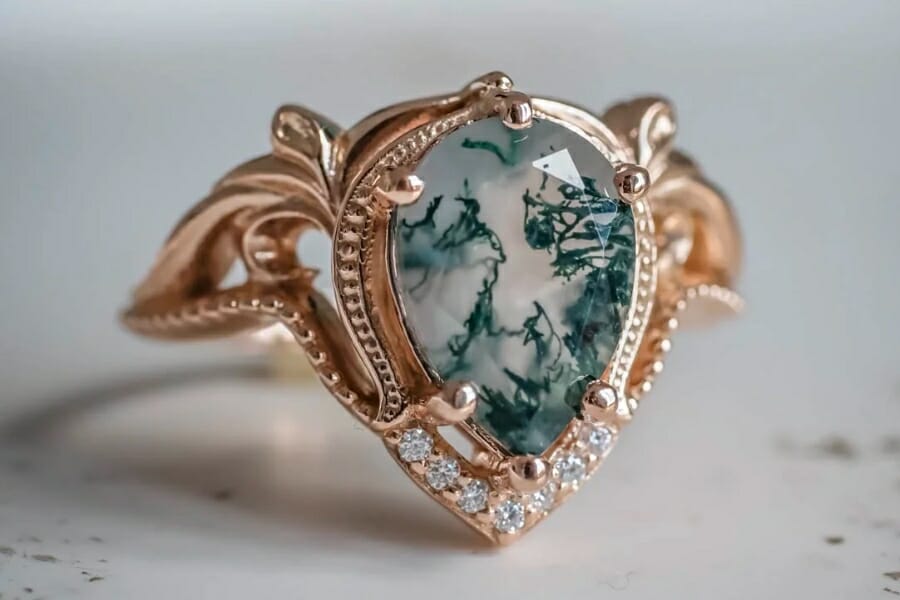A gemstone that’s been around for thousands of years, yet still manages to impress us with its beauty and versatility— none other than the good old Agate! If you haven’t seen many up close and personal you are really missing out.
Agate is a type of chalcedony that comes in a variety of colors and patterns, making it a popular choice for jewelry and home decor. It’s a rockstar when it comes to enhancing emotional and mental balance, offering stability and grounding in times of stress or uncertainty according to many.
Plus, it’s just plain gorgeous to look at. Who wouldn’t want to adorn themselves with a bit of Agate bling?
But don’t just take our word for it, because we’re going to dive deep into the many benefits and uses of Agate, and explore why it’s truly worth its weight in gold. Prepare to be dazzled by the wonder that is Agate.
What Agate Is
An Agate is like a kaleidoscope in a stone. Its varying colors and patterns keep every specimen interesting and mesmerizing to look at.
This gem is a type of chalcedony, which is a mineral in the quartz family. It’s formed when water containing minerals seeps into rock cavities and slowly evaporates, leaving behind colorful bands of mineral deposits.
One of the best things about Agate is that it comes in so many different varieties, and in order to understand Agate’s true value, we’ll discuss with you each of them.
Agate is also one of the more easily found stones that end up as the prize of many collections. It’s relatively common in many places and really looks incredible when polished.
Banded (Fortification) Agate
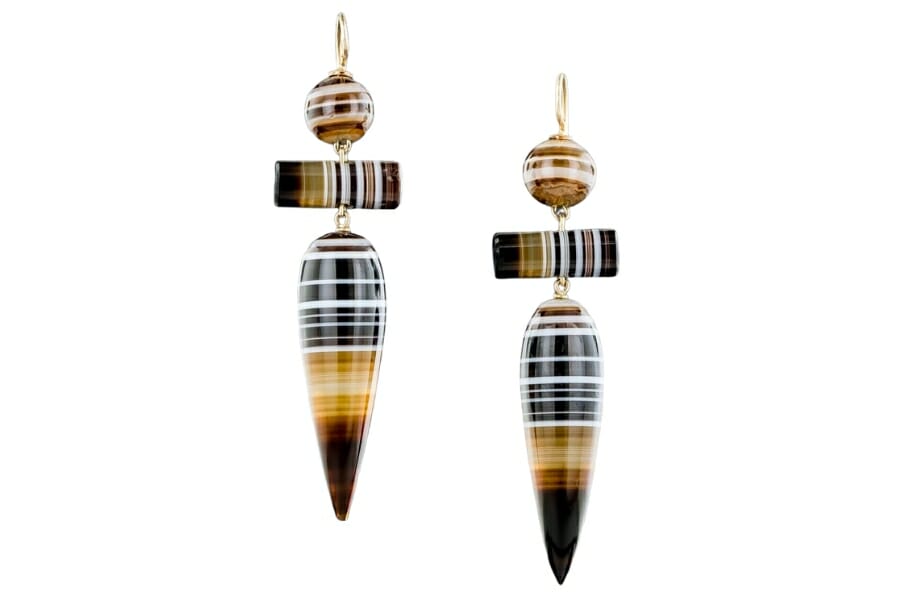
Banded Agate is characterized by its distinctive bands or layers of color that often resemble the walls of a fortress or castle, hence the name “Fortification” Agate. Its bands are formed when the mineral-rich water that fills rock cavities and fractures in the earth’s crust slowly evaporates, leaving behind concentric layers of minerals. These layers can be made up of different types of chalcedony, quartz, or other minerals, which can give the Agate a wide range of colors and patterns.
Banded Agate can be found all over the world. In fact, it’s the most common type of Lake Superior Agate out there, too.
How much is Banded (Fortification) Agate worth
Banded or Fortification Agate’s price is currently set at $0.4 to $45 per carat.
Fire Agate
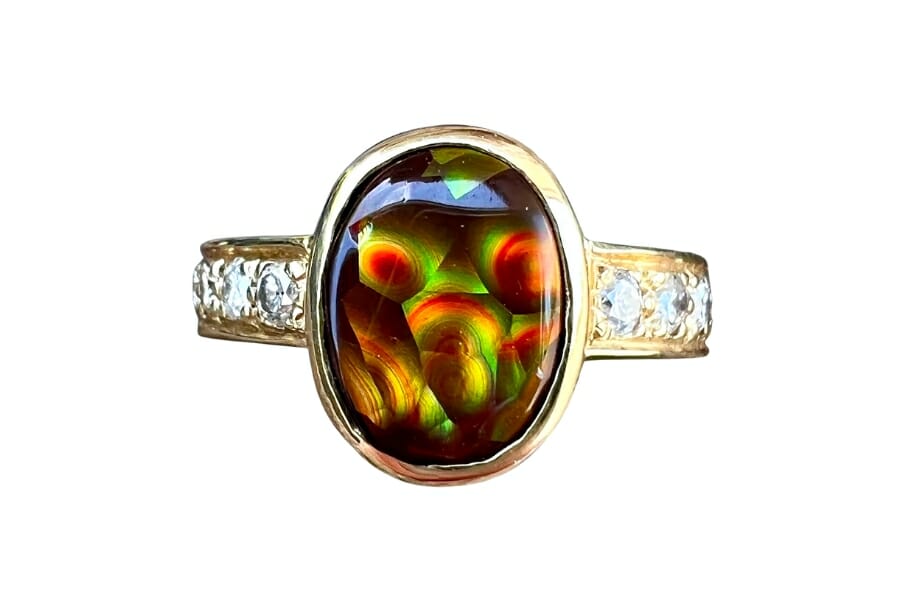
This unique and stunning variety of Agate is prized for its fiery coloration and iridescent flashes of light. Fire Agate is formed from a type of chalcedony that’s rich in iron and manganese, and gets its distinctive coloration from the thin layers of these minerals that form within the stone.
What sets Fire Agate apart from other types is its play of color. When light reflects off the thin layers of iron and manganese, it creates a rainbow-like effect that seems to dance and shift as you move the stone. This effect is known as “fire”, which is how the stone got its name.
How much is Fire Agate worth
Fire Agate typically commands a price of $1.5 to $25 per carat, depending on how beautiful the display of fire is.
Lace Agate
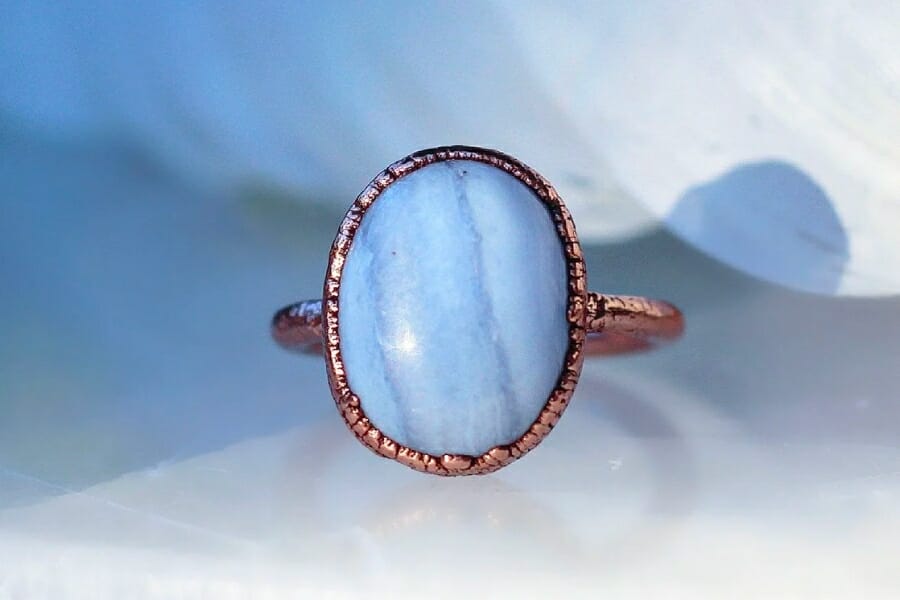
Lace Agate is a delicate and ethereal variety that’s characterized by its lacy, web-like patterns of white and blue or white and gray. The name “lace” comes from the intricate, fine lines that resemble delicate lacework.
This variety is formed when mineral-rich water seeps into cavities in volcanic rock and evaporates, leaving behind these intricate patterns of chalcedony. The patterns of Lace Agate can be quite varied, from fine, delicate lines to bolder, more dramatic swirls.
How much is Lace Agate worth
A Blue Lace Agate cabochon sells at the price of $8 to $30 per carat.
Moss, Dendritic, and Plume Agates
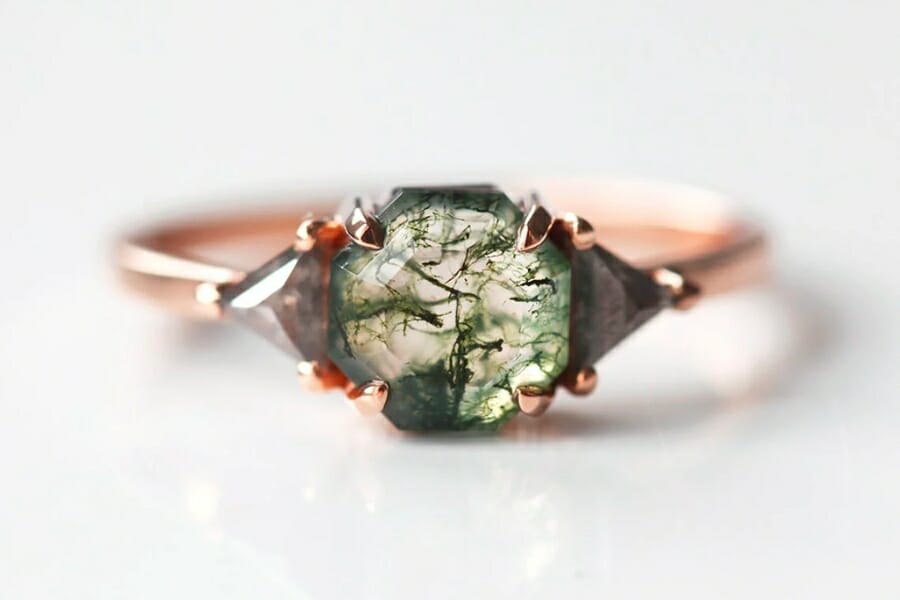
Moss Agate is characterized by its greenish inclusions, which resemble tiny plants or moss growing inside the stone. These inclusions are actually iron or manganese oxide, which form in intricate, branching patterns.
On the other hand, Dendritic Agate, also known as Tree Agate, has delicate, tree-like inclusions that are typically black or brown, and can resemble tree branches, roots, or even ferns.
Plume Agate, meanwhile, is characterized by its wispy, feather-like inclusions, which can resemble plumes of smoke or clouds. These inclusions can be white, gray, or a range of other colors, and are formed from various types of chalcedony.
How much are Moss, Dendritic, and Plume Agates worth
These interesting varieties of Agate can be sold at $16 to $240 per carat, depending on the intricacy, beauty, and overall appeal of its inclusions.
Picture or Scenic Agate
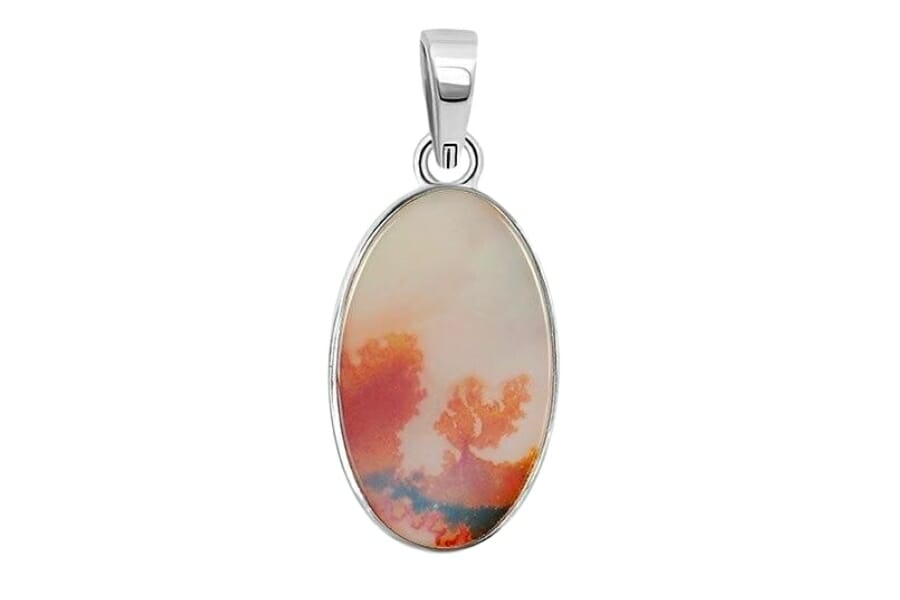
Picture Agate, also known as Scenic Agate, is prized for its unique and intricate patterns, which often resemble miniature landscapes or pictures. These patterns are formed by layers of chalcedony and other minerals that create intricate scenes, such as forests, mountains, and waterfalls.
One of the most fascinating things about Picture Agate is that no two stones are exactly alike. Each one has its own unique pattern, created over millions of years by the slow process of mineral deposition. This makes it a highly sought-after gemstone, and one that’s sure to capture the imagination of anyone who sees it.
Picture Agate is found in a number of locations around the world, including the United States, Brazil, and Madagascar. It’s often used in jewelry and decorative objects because of its unique and breathtaking beauty.
How much is Picture or Scenic Agate worth
Because of its interesting landscape, a Picture or Scenic Agate’s price is at $13 to 21 per carat.
Agate Fossil
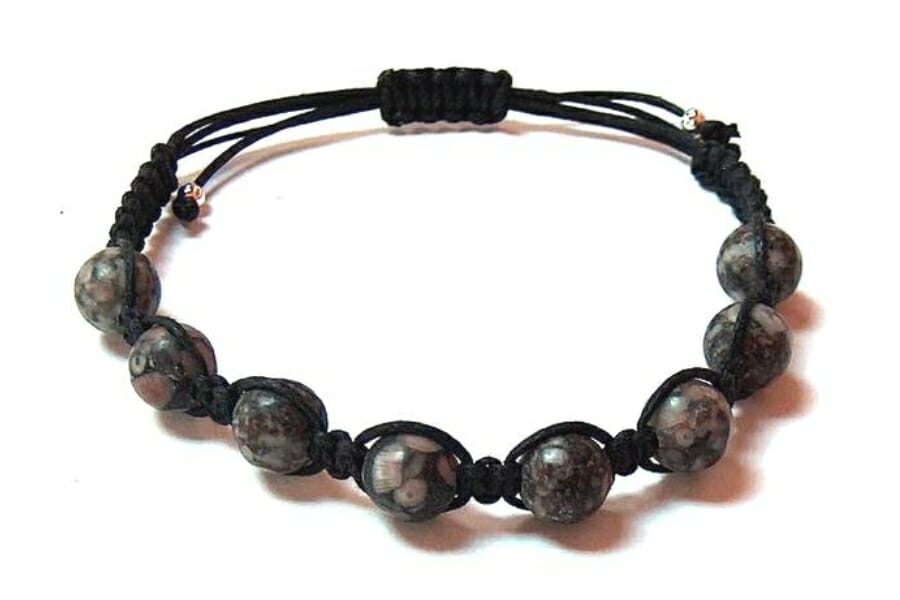
Agate fossil contains preserved organic material, such as plants, animals, or other organisms, that lived millions of years ago. These fossils are formed when mineral-rich water seeps into the cavities left by the decomposing organisms, filling them with layers of chalcedony and other minerals.
Over time, the minerals in the water replace the organic material, preserving it in stunning detail. The resulting Agate Fossil often has intricate patterns and colors that are reminiscent of the original organism.
In addition to their aesthetic value, Agate Fossils are also of scientific interest, as they provide important insights into the evolution and diversity of life on Earth.
How much is Agate Fossil worth
An Agate Fossil’s price is pegged at $5 to 9 per carat, showing how valuable it is not only for its beauty but also for its value in the scientific community.
Iris Agate
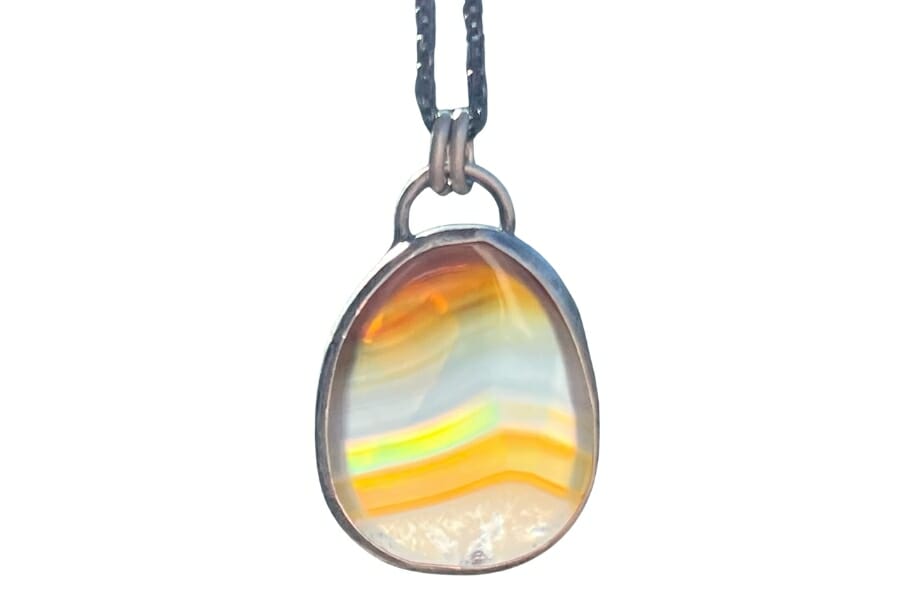
Prized for its stunning rainbow-like colors and iridescence, the name of Iris Agate comes from the Greek word for “rainbow” and refers to the gemstone’s beautiful array of colors.
Iris Agate is formed when layers of chalcedony and other minerals create a thin, translucent layer over a darker, opaque layer of rock. Light passing through the translucent layer is refracted and dispersed, creating a spectrum of colors that can include blues, greens, purples, and yellows.
How much is Iris Agate worth
The price range for Iris Agate is typically between $1 and $4 per carat.
Turritella (Shell) Agate
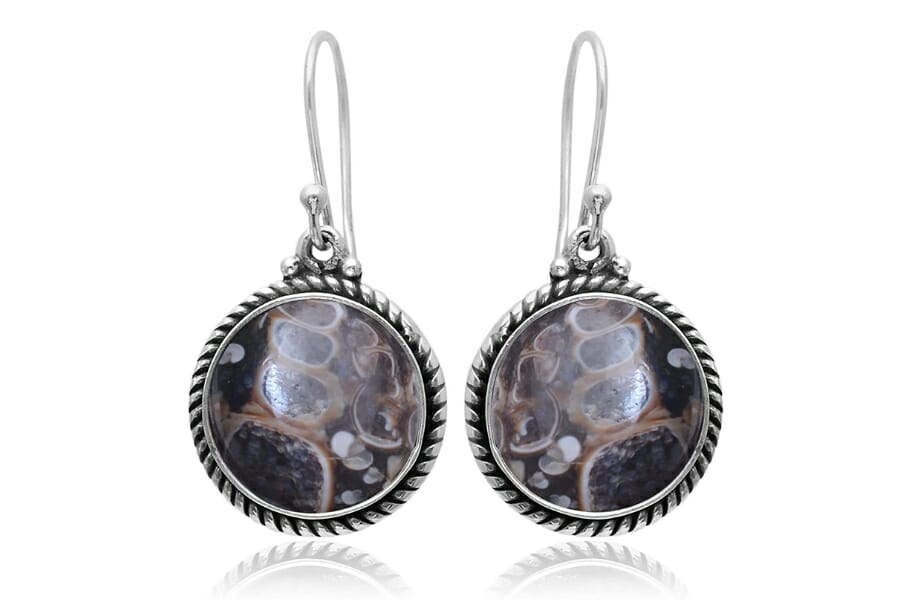
Turritella Agate, also known as Shell Agate, contains fossilized snail shells, often in intricate and beautiful patterns. These shells are from ancient marine creatures known as Turritella, and they’re typically brown or black in color, contrasting with the lighter-colored chalcedony that forms the agate.
The fossilized shells in Turritella Agate provide a fascinating glimpse into the natural history of the planet, as they can be millions of years old. In addition to their scientific value, they also give the gemstone a unique and striking appearance, reminiscent of a forest floor covered in leaves and twigs.
How much is Turritella (Shell) Agate worth
If you’re interested in buying a Turritella Agate, you can expect to pay between $0.03 and $0.8 per carat.
Why Agate Is So Expensive
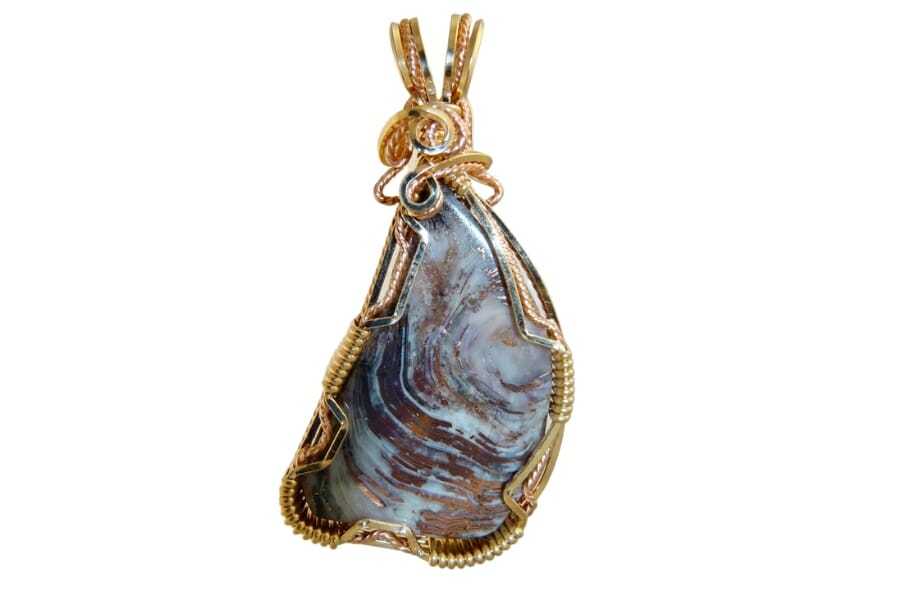
Agates are one of the most sought-after gemstones in the world, and for good reason. Their unique patterns, colors, and textures are unlike anything else in the natural world. But why are Agates so valued, and why do they often command high prices in the gemstone market?
One of the main reasons is their beauty. Each Agate is unique, with its own distinct patterns and colors that are formed by the slow accumulation of mineral layers over millions of years. Some Agates have swirling bands of colors that resemble the patterns of a kaleidoscope, while others have delicate, lacy patterns that look like they’ve been embroidered onto the stone.
Another reason is their rarity. While Agates can be found in many locations around the world, truly exceptional specimens are relatively rare. The best ones are those that have been formed under just the right conditions, with a perfect balance of minerals, water, and temperature. This means that top-quality Agates can be hard to come by, which drives up their value.
Finally, Agates are also valued for their metaphysical properties. Many people believe that they have a variety of healing and protective properties, such as promoting balance, calming the mind, and enhancing creativity. While these properties are not scientifically proven, they add to the mystique and allure of these fascinating gemstones.
When it comes to the different types of agates, it’s fairly common to mistake them for each other and for other minerals. If you’re not 100% sure what it is that you have, check out our guides below:
How To Determine The Value Of Agate
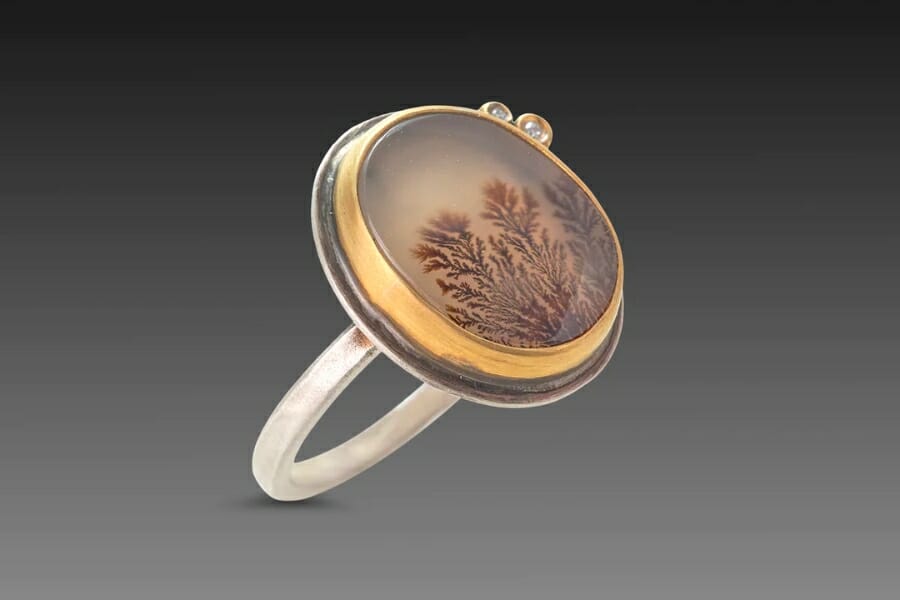
Agate’s value varies depending on the following factors:
Type
The type of Agate plays a major role in determining its price. Some types, such as Fire or Moss, Dendritic, and Plume Agates, are rarer and more desirable than others, which can drive up their value. Additionally, other types may have unique properties or patterns that make them more valuable to collectors or gemstone enthusiasts.
For example, Picture or Scenic Agate, which has intricate, picturesque patterns that resemble landscapes or scenes from nature, is highly prized by collectors and can command high prices. Similarly, Iris Agate, which has a distinctive play of color similar to opal, can also be quite valuable due to its rarity and beauty.
Color and Pattern
Some colors of Agate are more desirable than others, and can command higher prices as a result. For example, specimens with vibrant, saturated colors may be more valuable than those with more muted tones.
Similarly, Agates with intricate and complex patterns are often more sought after than simpler ones.
Clarity
Agates that are free of cracks, blemishes, or other imperfections are more valuable and considered of higher quality than those with flaws.
Inclusions
Agate is known for its natural patterns, banding, and inclusions. Many specimens of this gemstone have natural inclusions or patterns that are highly sought after by collectors, such as Dendritic, Plume, or Moss agate. These inclusions add to the overall beauty and uniqueness of the stone, and even increases its value.
Cut
Cutting and shaping Agate can greatly impact its price, as it can enhance its beauty and bring out its natural patterns and colors. A well-cut and polished Agate will typically be more valuable than a rough or poorly finished specimen, as it can be more appealing to collectors and enthusiasts.
The way an Agate is cut can also impact the display of its unique patterns and colors. Some cuts, such as the cameo cut, can create intricate and detailed designs within the stone, which can be highly prized by collectors.
Carving and Craftsmanship
It takes skill and artistry to transform a rough stone into a polished and intricately detailed work of art, so the more intricate and detailed the carving is, the higher the price may be as it requires more time, effort, and skill on the part of the craftsman.
The quality of the craftsmanship is also an important factor affecting Agate’s value. A well-carved specimen with clean lines, smooth curves, and precise details will generally be more valuable than a poorly executed or rough carving.
Origin
Agates that come from certain locations or regions may be more highly prized than those from other areas, due to their unique characteristics or rarity.
For example, Agates from Brazil, such as the famed Rio Grande do Sul Agates, are highly prized for their vivid colors and intricate banding patterns. Similarly, those from certain locations in the United States, such as Oregon or Montana, may be more valuable due to their rarity or unique characteristics.
Treatments and Enhancements
While natural, untreated Agates are generally more highly prized than treated or enhanced ones, some treatments, such as dyeing and heating, can enhance the beauty and value of an otherwise unremarkable piece.
Enhancements such as polishing or shaping can also impact the value of an Agate, with a well-polished and precisely-shaped stone commanding a higher price.
Size
Larger pieces of Agate are generally more valuable than smaller pieces, as they offer more surface area for displaying the stone’s unique patterns and colors.
Agate Price By Type
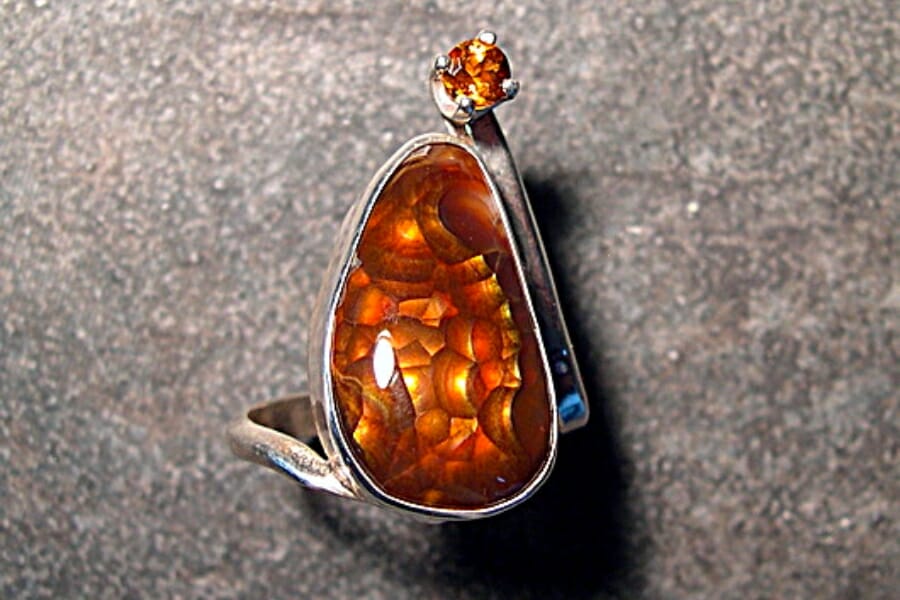
As we’ve mentioned above, the type of Agate has the most influence on its price and value. In this section, we’ll share with you the current market prices of this gemstone depending on type.
Agate values by type
| Type | Price (Per Carat) |
| Agate Fossils | $5 – $9 |
| Banded (Fortification) Agate | $0.4 – $45 |
| Blue Lace Agate | $8 – $30 |
| Fire Agate | $1.5 – $25 |
| Iris Agate | $1 – $4 |
| Moss, Dendritic, and Plume Agate | $16 – $240 |
| Turritella (Shell) Agate | $0.03 – $0.8 |
To give you a better idea of how much Agate in general costs, here are its prices based on different units of measurement.
Agate pricing by unit of measurement
| Measurement | Price |
| A carat of Agate | $0.03 to $240 |
| A gram of Agate | $0.15 to $1,200 |
| An ounce of Agate | $4 to $34,019 |
| A kilogram of Agate | $150 to $1,200,000 |
| A pound of Agate | $68 to $544,310 |
| A ton of Agate | $136,078 to $1,088,622,000 |
The Most Expensive Agate
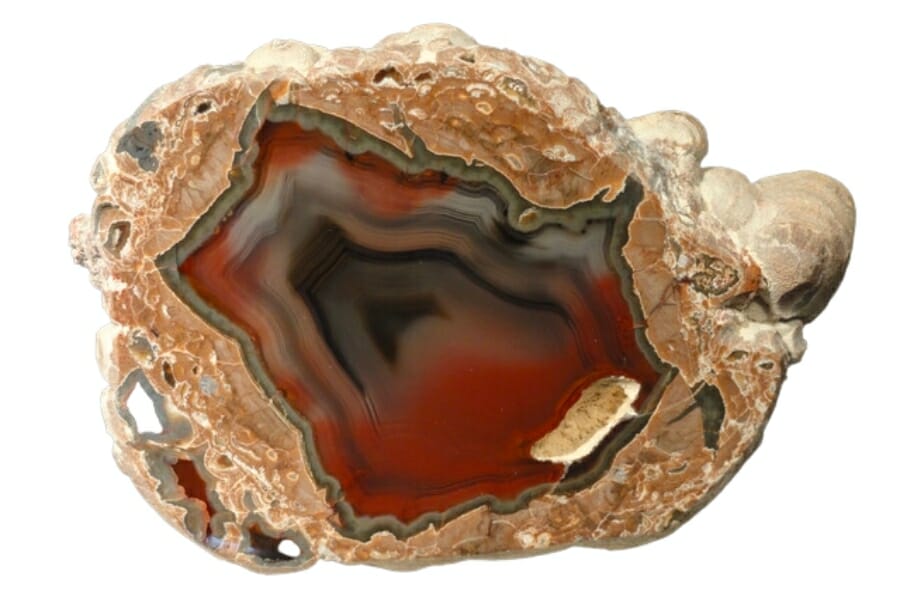
There is no official record of the most expensive Agate ever sold as its value can vary greatly depending on many factors.
However, one particularly notable agate is the “Mozarkite” Agate, which is found exclusively in the Missouri Ozarks region of the United States. This specimen is known for its striking colors, intricate banding patterns, and exceptional hardness, and is highly sought after by collectors and lapidary enthusiasts.
In 1967, a particularly large and impressive Mozarkite Agate was discovered in a quarry near Licking, Missouri, which weighed over 200 pounds and measured over three feet in diameter. The stone was named the “Burrus Ranch” Agate after the property where it was found, and quickly gained fame as one of the largest and most beautiful Mozarkite specimens ever discovered.
The Burrus Ranch Agate was eventually purchased by a collector for an undisclosed sum, rumored to be in the hundreds of thousands of dollars. While it’s difficult to determine the exact value of the stone, due to its unique and rare characteristics, it’s undoubtedly one of the most valuable and impressive Agates ever discovered, and a testament to the beauty and appeal of this remarkable gemstone.
How To Get An Appraisal On Your Agate
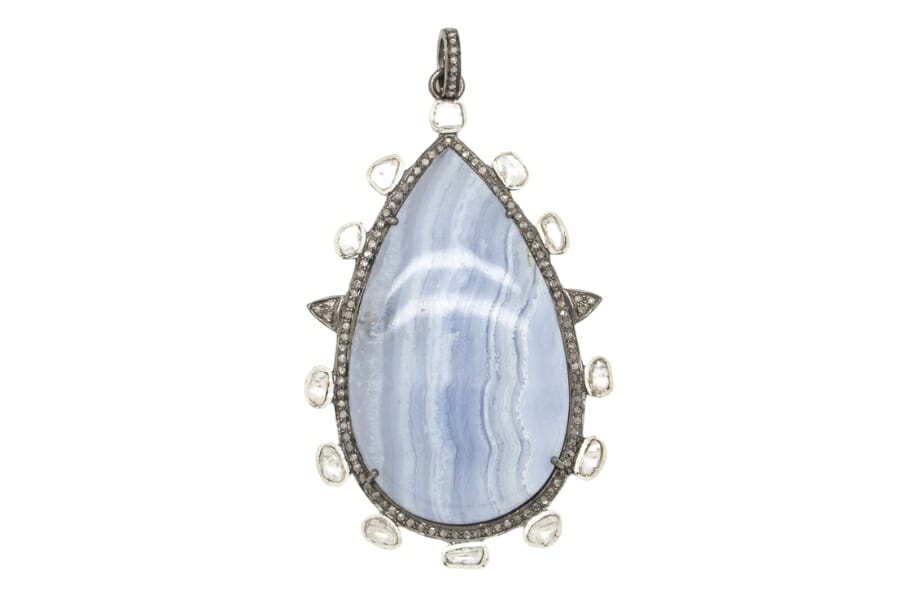
While our discussion above already provides a comprehensive view of how much Agate is worth, the different factors that affect its price may mean that each and every specimen will have different estimated values as well.
If you’re after the best estimate of your Agate’s value, we highly recommend looking for professional appraisers. Check their credentials, references, and reputation to ensure that you’re working with a trustworthy and knowledgeable one. Find appraisers who are accredited by reputable organizations, such as the Gemological Institute of America.
Also, to help your appraiser provide the best estimate, be sure to provide detailed information, including the specimen’s distinguishing characteristics. The more information you can provide, the more accurate the appraisal is likely to be.
If you have ample resources, you may also want to consider getting multiple appraisals, as it will give you a better sense of your Agate’s price. Through this all, though, always make sure to have an open mind and to be realistic with your expected appraisal.

